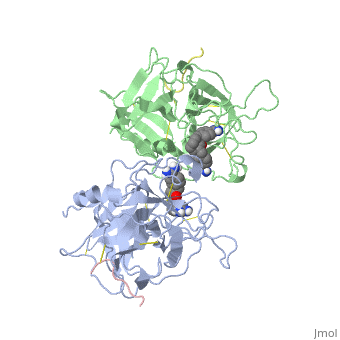Tissue-type Plasminogen Activator – usually called t-PA – is a trypsin-like serine protease that catalyses the conversion of zymogen plasminogen into plasmin. Once present in the blood, plasmin – which is an active enzyme – degrades fibrin clots, the product of a coagulation. tPA is clinically used as a treatment for acute ischemic strokes, myocardial infarction and pulmonary embolism.
Interactions with other proteins
t-PA proteins interacts with LRPs (lipoprotein receptor-related proteins) which are produced in endothelial cells. This interaction leads to NF-κB (Nuclear Factor-Kappa B) activation and MMPs (Matrix metalloproteinases) overexpression, by the activation of latent PDGF-CC (Platelet-derived growth factor receptors).[1]
t-Pa also interacts with the N-methyl-D-aspartate (NDMA) receptor, and annexin-II which are both in glial cells and neurons. This interactions leads to deleterious effects because it results in parenchymal cell death. [1]
t-Pa induces the overactivaton of MMP-3 (the effector arm of the change of cerebrovascular permeability [2]) and MMP-9, which are two marker proteins of the Brain Blood Barrier (the current research on t-PA are focused on finding a way to stop this overactivation).[1]
The deleterious effects of t-PA is all about the interaction with LRP, so a combine therapy of tPA and LRP antagonist could be useful for clinical treatments [1], but currently no evidences of this type of treatment has been published.
Medical uses and Clinical evidences
Numerous clinical test were performed on t-PA, this molecule is currently the unique treatment for acute ischemic stroke. But as noticed in the previous section, t-PA is associated with increased risk of cerebral haemorrhage and brain injury. [3].
In case of mouse experimentation, the FCII (focal cerebral ischemic injury) size was smaller in the WT (Wild Type) mice than in the t-PA −/−. [3]
Otherwise, the treatment of PVT (Portal vein thrombosis) in pregnant woman have success rate (but induces foetal mortality of 20%).[4]
With advances in Bio-Engineering, several generation of tPA derivatives have progressively reached clinical trials but none has demonstrated benefits so far.[1]
Structure of the catalytic domain of human tPA complexed with Bis-Benzamidine
The tissue-type Plasminogen Activator is a 69-kDa multidomain glycoprotein, which consists in a single polypeptide chain of 527-530 amino acids [1]. There is three types of domain: F1 (homologous to fibronectin type I), G (epidermal growth-factor like) and kringle.[5]
The structures described below correspond to the structure of the catalytic domain of humain tPA in complex with a Bis-Benzamidine. The catalytic domain of a protein is the part of the enzyme that reacts with the substrate to induce the enzymatic reaction and benzamidine is an organic compound often used as an inhibitor.. Thus, the complexation of t-PA with bis-benzamidine revealed a strong structural similarities to other trypsin-like serine proteases, as alpha-chymotrypsine. tPA is known for its high specificity : tPA recognizes complexes or multiple elements on the surface of plasminogen, even distant form its cleavage site. In vivo, the tPA cleavage site is a single bond of plasminogen formed by the residues Arg560-Val561 [6].
Few t-PA-specific inhibitors are known. Synthetic inhibitors for t-PA-like proteins has been based on Arginin and Lysin residues derivatives and the structurally related benzamidines.
Many specific features of the protein involve interactions with surface elements of the catalytic domain. By the way, the two-chain tPA shows almost no structural differences when complexed with bis-benzamidine compound. The binding of the bis-benzamidine to tPA is determined by two interaction sites. The first group binds in the specificity pocket while the second group fits in an hydrophobic groove, resulting in an extended binding of the inhibitor [6].
The tPA complexed with bis-benzamidine structure shows that the side chain of the Arg174 residue can adopt multiple conformations.
Asp 174 at the bottom of S1 specificity-pocket results in a negatively charged environment. The S4 pocket, delimited by the side chain of Tyr99 at its eastern side, Trp215 at the bottom and the aliphatic part of Arg174 at its western border, provide the entrance frame hydrophobic. The negative cavity is form at the north of the S4 pocket. The major determinants for interactions with substrates and inhibitors would appear to be binding in the hydrophobic S4 substrate, together with weak electrostatic interactions at the electronegativity cavity.[6]
See also
Plasmin
Serine protease

